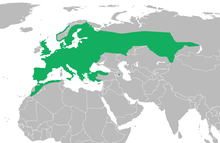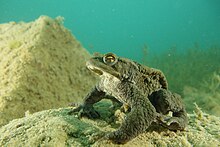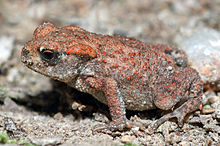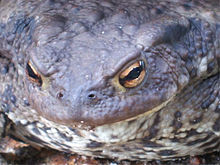Common toad
| Common toad | ||||||||||||
|---|---|---|---|---|---|---|---|---|---|---|---|---|

Common toad ( Bufo bufo ), female |
||||||||||||
| Systematics | ||||||||||||
|
||||||||||||
| Scientific name | ||||||||||||
| Bufo bufo | ||||||||||||
| ( Linnaeus , 1758) |
The common toad ( Bufo bufo ) is a common and Palaearctic space widespread Froschlurch from the kind of genuine toads within the family of toads (Bufonidae). According to today's view, it is probably not a single biological species, but a complex of several taxa , the exact systematic position and delimitation of which is currently unclear.
In the first description, Carl von Linné first called the species Rana bufo , so classified it as a “frog” in the genus Rana .
The common toad was named Lurch of the Year 2012 by the German Society for Herpetology and Terrarium Science .
features
The body length of the males in Central Europe is up to nine centimeters, the females are up to twelve centimeters long. Female southern European representatives of the (controversial) subspecies Bufo bufo spinosus , which have pointed horny warts and white spots, can reach a head-trunk length of up to 15 centimeters. A spawning female of the nominate form can exceptionally weigh more than 150 grams; however, most adult common toads in Central Europe weigh approximately between 30 and 50 grams (males) or between 50 and 100 grams (females). The relatively plump animals have a stocky body, covered on top with warty skin glands, with a broad, short-nosed rounded head. On the back of it, there are strongly protruding, paired, bean-shaped glands ( parotid glands ) that contain skin toxins to ward off predators. The top is usually gray to red-brown; the males are sometimes black-brown or light-clay colored, while the females have more red components. There may also be dark spots that appear washed out, especially in males. The underside is dirty white in both sexes and speckled gray-black throughout. The pupils are horizontally elliptical, the iris appears copper-colored to red-gold (" amber-colored "). Common toads have quite short hind legs and walk on all fours, but also hop forward when alarmed. The males can also be recognized by the brown to black oestrus calluses on each of the three inner fingers during the mating season . They also have stronger forelegs, a flatter head and, on average, stay smaller than the females. Unlike green or natterjack toads, male common toads do not have sound bladders .
distribution
The common toad is the most common amphibian species in Europe , along with the common frog , pond frog and pond newt . It is widespread across almost the entire continent and is only absent in Ireland , Iceland and the far north of Scandinavia . There their area extends to the 68th parallel north. The common toad is also widespread in the Mediterranean countries, but is absent on many Mediterranean islands such as the Balearic Islands , Corsica , Sardinia , Malta and Crete . The situation in Russia is still insufficiently documented, especially in the Asian part, but the common toad can also be found there in a wide area. The Siberian Irkutsk on Lake Baikal is to be regarded as the most easterly occurrence today ; Information about common toads in the Far East of Russia up to the island of Sakhalin and Japan refer to earlier subspecies that have since been excluded (see below). The information from north-west Africa, in the north of Morocco , Algeria and Tunisia , as well as from the Iberian Peninsula refer to the Bufo spinosus, which many authors have now elevated to their own species . This makes it one of the most widespread amphibians of all. In Germany, the common toad is almost everywhere from the coasts to the Alpine region of the Alps before. However , it is missing on most of the North Sea islands.
Subspecies, taxa
The common toad belongs to a species complex of closely related and morphologically similar species, the " Bufo bufo species group". According to more recent studies, this can be divided into an eastern species group of East Asian species, including Bufo andrewsi , Bufo bankorensis , Bufo gargarizans , Bufo japonicus and Bufo minshanicus and a western species group to which Bufo bufo also belongs. In addition to Bufo bufo and possibly Bufo spinosus, two other species belong to the western group of species, the Bufo eichwaldi, described in 2008 from the Talysh Mountains in Azerbaijan and Iran, and the "Caucasian toad" ( Bufo verrucosissimus ), which is restricted to the Caucasus .
If you follow the separation of Bufo spinosus as a separate species, the species no longer has any subspecies apart from the nominate form Bufo bufo bufo .
The subspecies Mediterranean common toad ( Bufo bufo spinosus ), which is morphologically different in the Mediterranean area of Europe, Asia Minor and Northwest Africa , which is supposed to be larger and provided with pointed horny warts and white spots, cannot be maintained in its earlier form according to recent studies. After phylogenomic investigations by comparing homologous DNA sequences and on the comparison of allozymes the Erdkrötenpopulationen the Iberian Peninsula, North West Africa and France were (west of a line between Caen and Lyon) and the Channel Island of Jersey by Ernesto Recuero and colleagues in 2012 as Bufo spinosus to own Kind raised. Joan Garcia-Porta and colleagues were able to find the same differentiation on the basis of independent data, but retained the subspecies of the Iberian / North African group as Bufo bufo spinosus in a new definition. Although these are essentially morphologically hardly distinguishable cryptospecies , morphological identifying features have now also been given: the parotid divergent when viewed from the head and the shape of the metatarsal tubercles in the male. Animals from the eastern Mediterranean, which were previously also included in the subspecies spinosus , belong to the nominate form of Bufo bufo ; attempts to find morphological differentiating features were also unsuccessful here. The animals are somewhat larger in the south, but the characteristics vary clinically .
The subspecies status of Bufo bufo gredosicola , native to the Sierra de Gredos in central Spain, is controversial; possibly it is just a high mountain form of " spinosus ". According to genetic research, the subspecies is not justified.
Habitat, way of life
The common toad is a cold-blooded animal that is generally crepuscular. During the day the animals rest under stones, crumbling walls, dead wood, leaves, bushes or in self-dug holes in the ground. As rural habitats, they populate a broad spectrum of biotopes , ranging from forests to semi-open landscapes of meadows, pastures and hedges to near-natural gardens. Herb-rich forests (especially deciduous and mixed forests) without complete canopy are particularly preferred; The settlement density is somewhat lower in the closed high forest. Flood plains are not completely avoided either, but they are less cheap. Compared to other amphibian species, the common toad occurs more frequently in damp to dry forests. Orchards and park-like landscapes are particularly popular because of the varied structures. The species can also be found in drier habitats (e.g. vineyards, sand pits), but avoids hot and dry areas.
Their appearance in settlement areas, parks, gardens, allotments, backyards, damp cellars, ruins and cemeteries justifies the designation "cultural follower". Common toads can sometimes be found even in the middle of smaller towns. Intensive arable land without field trees, land-adjusted vineyards and large-scale conifer monocultures are particularly unsuitable as living space . The species cannot exist even where there is a lack of spawning water.
Medium-sized to larger ponds, ponds and lakes are mainly used as reproductive waters. Still waters in or near the forest are being populated with great steadiness. The common toad, however, avoids shallow and silting bodies of water; a sufficiently large free water body is a prerequisite for use as a spawning habitat. The water depth should not be less than 50 centimeters; a weak flow is tolerated. Because of the inedibility of the larvae, the common toad, unlike other amphibians, spawns successfully in fish ponds.
Reproduction
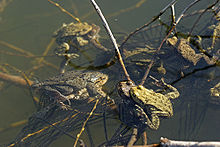
Central European common toads make their synchronous , often massive migrations from their winter quarters to the spawning waters in spring, usually in the course of March . Late frost breaks lead to the interruption of the hikes; the animals then bury themselves on the spot and remain in the ground until the weather conditions allow the migration to continue. Because of their slow movement and their large radius of action, common toads are highly endangered by road death (see chapter “Endangerment and Protection”).
As soon as a male ready to mate spies a (supposed) female, it tries to climb onto its back and now clings with its arms behind the armpits of the female (for more details see: Amplexus ). This can also happen during the hike - then the male can be carried piggyback to the water. Since there is a strong excess of males in many common toad populations (often in the ratio of 3 to 1 or even more), this is an opportunistic behavior to ensure the finding of a partner. Rivals are kept at a distance with heavy kicks.
Male common toads seldom utter a quiet, slow call in spawning waters that sounds like "öök ... öök ... öök ..." and is sometimes metallic creaking. This can usually be observed outside the relatively short spawning season or in waters where very few common toads are found. The mating calls of the males in well-frequented spawning waters play a minor role in pairing, since common toads often spawn in large societies in the same body of water ("traditional spawners") and also spawn in a closely synchronized manner. Short, louder sounds emitted in quick succession (“ük, ük, ük”) are “calls of liberation” from males that are erroneously bracketed by other males. These vocalizations can be heard much more frequently than the actual pairing calls.
The spawn is released in the form of cords that are five to eight millimeters thick and about two to four (five) meters long, depending on how stretched they are. The black eggs are usually arranged in two-row chains within the jelly. The spawning cords are wrapped around structures underwater (branches, aquatic plants) by the pair of toads by swimming around during spawning. Only when the spawn emerges from the female cloaca does the male release his sperm , forming a funnel with his hind feet. Immediately before spawning, the female forms a hollow back and triggers wave-like muscle contractions, so the male is signaled the right time to do so. A total of 10 to 20 spawning batches with breaks in between mean that the entire spawning process takes about 6 to 12 hours. The number of eggs in a female is usually 3000 to 6000 (extreme values: 750 to 8100); each is 1.5 to 2 millimeters in diameter.
After several days of the embryonic phase (the duration depends on the ambient temperature), the tadpoles develop from the spawn . In the common toad, these are uniformly black in color and ultimately grow up to 40 millimeters long. Depending on the nutritional status and other environmental influences, a larva can also remain a little smaller. The upper fin edge of the oars tail, which is rounded at the back, just reaches the end of the body, so it is not particularly large and wide. The larvae often swim gregariously in broad or elongated swarms in upper, warmer water layers and graze on algae and detritus from surfaces. If a conspecific dies, the others act as scavengers. After about two and a half to three months in the water, the tadpoles metamorphosis into lung-breathing, four-legged land animals and often go ashore in large numbers at the same time. The vernacular speaks of "frog rain" because of the young toads that seem to swarm everywhere. The freshly transformed landwalkers are initially only between 7 and 12 mm in size. The body length has not only been reduced due to the receding oar tail, but also the torso initially shrinks slightly during the metamorphosis compared to that of the tadpole. Such a “shrinkage transformation” is not unusual in frogs.
After about three (to five) years, the animals become sexually mature. In the wild they have a life expectancy of no more than ten to twelve years; in captivity, a common toad is already 36 years old.
nutrition
The food of common toads consists of worms , snails , woodlice , spiders and various insects that they prey on their nocturnal forays. The snapping - either a flick of the tongue or, in the case of larger objects, a thrust of the entire body and grabbing with the jaws - is triggered by movements of the prey. Motionless animals are not noticed by the toads. The prey is swallowed whole; the eyeballs are often drawn in when swallowing. Common toads pull earthworms through their fingers like " spaghetti " to remove dirt particles before they are eaten. Larger common toad populations are important for pest control in “chemical-free” horticulture and agriculture .
Molting, skin toxins
The animals shed their skin at irregular intervals. To do this, the old, bursting outer layer of skin is stripped from the limbs and torso in twisting movements and with wide open mouths.
The skin glands of the toads produce poisonous secretions, which serve the passive defense against predators, but also as protection against attack of the skin by microorganisms . They contain, among other Bufadienolides that are similar to the Digitalisgift of foxglove act, and bufotenine (real Bufotenin, Dehydrobufotenin, O Methylbufotenin) issued against predators blood pressure increase and the motor centers of the brain and spinal cord paralyzed. Other ingredients are biogenic amines such as adrenaline , noradrenaline , catecholamines , dopamine and epinine . Toad poisons are the longest known animal poisons and have been used as remedies since ancient times.
Enemies
Among the predators of common toad include carnivores such as, among others, marten species , cats , raccoons , raccoon dogs , snakes like the grass snake and some gripping and crows and herons . Young toads are also preyed on by songbirds and large ground beetles . The tadpoles prey on predatory fish such as European pike and perch as well as larvae of aquatic insects such as the yellow beetle or dragonflies .
The natural enemies also include the green shimmering gold toad fly ( Lucilia bufonivora ). This blowfly species lays its eggs on the back of the head or on the back of amphibians, especially common toads, in the summer months. The larvae, which hatch after two to three days, crawl to the toad's snout and penetrate the nasopharynx through the nostrils. Here the parasites eat their way through the head tissue and deform the front part of the head of the infected animal beyond recognition. After a few days, the toad usually perishes and the maggots complete their development into blowflies on the carcass. It is unclear to what extent this parasitosis occurs in common toads and affects their populations. Usually only chance observations of diurnal, disoriented specimens with - depending on the stage of development - more or less noticeably deformed or destroyed snout area succeed.
Another parasite is the flat cone ( Hemiclepsis marginata ), which sucks blood in toads until they die.
Particularly noteworthy among the mammals is the polecat , which sometimes causes real massacres in common toad spawning societies by injuring or killing the animals in large numbers and then leaving them individually or in bulk on the bank.
Attacks by crows ( Corvus spp.) On common toads led to toad explosions in Hamburg in 2005 due to the natural defense reaction of the toads .
Hazard and protection

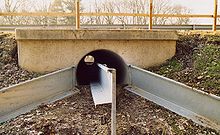
Common toad populations are particularly threatened by the fragmentation of their habitats by roads. During their annual migrations, especially from their winter quarters to the spawning waters and later from there to the summer habitat, they suffer high losses from motor vehicle traffic all over Central Europe. Many amphibians, including common toads, fall into unsecured cellar shafts and starve or dry up there. The gullies of the public street drainage are also a big problem. Frogs, toads and newts get through the slots in the manhole covers into the manholes and are drifted through the sewage network or perish in the dirt collector - at the latest when the rubbish is pumped out.
Legal protection status (selection)
- Fauna-Flora-Habitat Directive (FFH-RL): not listed
- Federal Species Protection Ordinance (BArtSchV): not listed separately. but: all European amphibians are specially protected
- Federal Nature Conservation Act (BNatSchG): "specially protected" via the Federal Species Protection Ordinance (Section 7, Paragraph 2, No. 13)
National Red List classifications (selection)
- Red List Federal Republic of Germany: not endangered
- Red list of Austria: NT (threat of danger)
- Red list of Switzerland: VU (corresponds to: endangered)
Protective measures for the benefit of migratory common toads and other amphibian species are now being implemented on many roads. These can be temporary “toad fences” made of plastic, on which the migrating animals run until they fall into collecting bins and are carried across the street by helpers. These toad fences are usually only in place during the migration of the adult animals, in some cases also at the time of the migrating metamorphosed young toads in June to August. Some streets are specially closed for the time of the main hikes. Replacement spawning waters are also being created, which are positioned so that the animals no longer have to cross busy roads. However, the local toads have to accept a new body of water first. Finally, animal passages ( toad tunnels ) are built under the roadway when roads are being expanded or newly built, to which the toads are guided by means of permanently installed guiding devices. In North Rhine-Westphalia, for financial reasons, 78% had temporary safety fences installed, 13% toad tunnels and 9% road closures.
In contrast to stationary amphibian protection systems, in contrast to stationary amphibian protection systems, the creation of new spawning waters at safe distances from busy roads can be a verifiable alternative for amphibian protection, especially in landscapes whose habitat structures are greatly changed by rewetting and succession processes. Here there is the possibility not only of creating improved spawning area conditions compared to the original spawning water (freedom from fish, better sunbathing), but also of opening up previously unpopulated land habitats for the animals. Even the common toad, which is relatively faithful to spawning grounds, masters the acceptance of such newly created waters by means of ecological plasticity. The forced spawning of individual pairs in spawning cages can also have a supportive effect. Artificial aging (structure enrichment through the introduction of spawning substrate such as branches and reed cuttings) can further accelerate the acceptance of new waters.
Cultural history
Until the Middle Ages, the toad was considered the ugliest animal of creation (cf. Leviticus 11, 29). She loves damp, dark places and measures the earth with her legs because she does not want to share. She can embody the devil , but also a protective house spirit. There is no clear distinction between the toad or toad and usually male imaginary frog , in narratives is also a close affinity to also poisonous snake (see Grimm fairy tales 105 Tale of the toad , also KHM 13 , 29 , 63 , 107a , 127 , 135 , 145 , 165 , 181 ). It was used in witches' ointments as well as in medicine , with both the toad poison and toad lard (the omitted fat from toad species) being found in recipes. The female uterus was imagined as a toad that could jump up and down in the body ( hysteria ), to which some votive offerings in the shape of a (common) toad can be traced back. In homeopathy , Bufo rana is used for mental drowsiness with migraines and cramps.
In the second half of the 20th century, common toads, along with other frogs, were used for the Galli-Mainini test to determine pregnancy in humans. A woman's morning urine or blood plasma was injected into the lymph sacs on the back of a male common toad. After 12 to 24 hours, a sample of the cloacal fluid was streaked out and examined under the microscope. If sperm was visible in this smear, the woman was pregnant. The toad's spermatogenesis is triggered by the hormone hCg ( human chorionic gonadotropin , a pregnancy hormone).
literature
- Dieter Glandt, Norbert Schneeweiß, Arno Geiger, Andreas Kronshage (eds.): Contributions to technical amphibian protection. (= Journal for Field Herpetology. Supplement 2). Bielefeld 2003, ISBN 3-933066-16-6 .
- Rainer Günther, Arno Geiger: Common toad - Bufo bufo (Linnaeus, 1758). In: R. Günther (Ed.): The amphibians and reptiles of Germany. Gustav Fischer Verlag, Jena 1996, ISBN 3-437-35016-1 .
- Hans Heusser: About the relationship of the common toad (Bufo bufo L.) to its spawning place. Part I In: Behavior. Volume 12, Brill, Leiden 1958, ISSN 0005-7959 , pp. 208-232.
- Hans Heusser: About the relationship of the common toad (Bufo bufo L.) to its spawning place. Part II. In: Behavior. Volume 16, Brill, Leiden 1960, ISSN 0005-7959 , pp. 93-109.
- Joachim Kuhn: Life history and demography of female common toad Bufo bufo bufo (L.). In: Journal of Field Herpetology. Volume 1, Westarp, Magdeburg 1994, ISBN 3-89432-493-7 , ISSN 0946-7998 , pp. 3-87.
- Josef Brzoska, Hans Schneider: Modification of prey-catching behavior by learning in the common toad (Bufo b. Bufo (L.), Anura, Amphibia): Changes in responses to visual objects and effects of auditory stimuli. In: Behavioral Processes. Volume 3, 1978, pp. 125-136.
- Hans Schneider, Ulrich Sinsch: Calls and calling behavior of the common toad Bufo b. bufo, in Hungary and a comparison with the advertisement call of the giant toad, Bufo b. spinosus. In: Journal of Field Herpetology. Volume 11, 2004, pp. 187-201.
- Ulrich Sinsch, Hans Schneider, David N. Tarkhnishvili: Bufo bufo super species - common toad species. In: Kurt Grossenbacher (Ed.): Handbook of the reptiles and amphibians in Europe. Volume 5 / II: Froschlurche (Anura) II (Hylidae, Bufonidae). Aula publishing house, Wiebelsheim 2009, pp. 191–335.
Web links
- Photos of the common toad at www.herp.it
- Bufo bufo in the Red List of Threatened Species of the IUCN 2009. (English; including distribution map)
- Information and photos at www.herpetofauna.at
- Database "Amphibian Species of the World" (English)
- Species portrait common toad at www.nabu.de
- Information at www.amphibienschutz.de
- Information at www.herpetofauna-nrw.de
- Common toad o-tones
- Videos on the common toad published by the Institute for Scientific Film . Provided in the AV portal of the technical information library .
Individual evidence
- ↑ a b Dieter Glandt: Pocket dictionary of the amphibians and reptiles of Europe. Quelle & Meyer, Wiebelsheim 2010, ISBN 978-3-494-01470-8 .
- ^ RF Inger: Bufo of Eurasia. In: WF Blair (Ed.): Evolution in the Genus Bufo. University of Texas Press, Austin / London 1972, ISBN 0-292-72001-7 , pp. 102-118.
- ↑ AMNH - American Museum of Natural History: Amphibian Species of the World
- ↑ S. Litvinchuk, L. Borkin, DV Skorinov, JM Rosanov: A new species of common toads from the Talysh mountains, south-eastern Caucasus: genome size, allozyme, and morphological Evidences. In: Russian Journal of Herpetology. Volume 15, 2008, pp. 19-43.
- ^ Jan W. Arntzen, John W. Wilkinson, Roland Butôt, Íñigo Martínez-Solano: A new vertebrate species native to the British Isles: Bufo spinosus Daudin, 1803 in Jersey. In: Herpetological Journal. Volume 24, No. 4, 2014, pp. 2099-2216.
- Jump up ↑ E. Recuero, D. Canestrelli, J. Vörös, K. Szabó, NA Poyarkov, JW Arntzen, J. Crnobrnja-Isailovic, AA Kidov, D. Coga˘lniceanu, FP Caputo, G. Nascetti, I. Martínez-Solano : Multilocus species tree analyzes resolve the radiation of the widespread Bufo bufo species group (Anura, Bufonidae). In: Molecular Phylogenetics and Evolution. Volume 62, 2012, pp. 71-86, doi: 10.1016 / j.ympev.2011.09.008 .
- ↑ J. Garcia-Porta, SN Litvinchuk, PA Crochet, A. Romano, PH Geniez, M. Lo-Valvo, P. Lymberakis, S. Carranza: Molecular phylogenetics and historical biogeography of the west-palearctic common toads (Bufo bufo species complex). In: Molecular Phylogenetics and Evolution. Volume 63, 2012, pp. 113-130, doi: 10.1016 / j.ympev.2011.12.019 .
- ↑ J. Arntzen, J. McAtear, E. Recuero, J. Ziermann, A. Ohler, J. van Alphen, I. Martínez-Solano: Morphological and genetic differentiation of Bufo toads: two cryptic species in Western Europe (Anura, Bufonidae ). In: Contributions to Zoology. Volume 82, 2013, pp. 147-169.
- ↑ Natalija Čađenović, Tanja Vukov, Ester Popović, Katarina Ljubisavljević: Morphological differentiation of the common toad Bufo bufo (Linnaeus, 1758) in the central part of the Balkan Peninsula. In: Archives of Biological Sciences. Volume 65, No. 2, 2013, pp. 685-695, doi: 10.2298 / ABS1302685C .
- ↑ Inigo Martinez-Solano, Elena G. Gonzalez: Patterns of gene flow and source-sink dynamics in high altitude populations of the common toad Bufo bufo. In: Biological Journal of the Linnean Society. Volume 95, 2008, pp. 824-839, doi: 10.1111 / j.1095-8312.2008.01098.x .
- ^ Andreas Nöllert, Christel Nöllert: The amphibians of Europe. Franckh-Kosmos, Stuttgart 1992, ISBN 3-440-06340-2 .
- ↑ Thomas Kordges: Strong infestation of the common toad (Bufo bufo) by the gold toad fly (Lucilia bufonivora MONIEZ, 1876). In: Journal of Field Herpetology. Volume 7, Laurenti-Verlag, Bochum / Bielefeld 2000, ISSN 0946-7998 , pp. 211-218.
- ↑ Common toad at www.wisia.de
- ↑ Online overview at www.amphibienschutz.de
- ↑ Arno Geiger, Klaus Weddeling: amphibian conservation measures on roads. In: Working Group Amphibians and Reptiles in North Rhine-Westphalia: Handbook of Amphibians and Reptiles North Rhine-Westphalia. Volume 2, Bielefeld 2011, pp. 1190–1206.
- ↑ Jacques Berlioz: Toad. In: Encyclopedia of Fairy Tales. Volume 8, 1996, pp. 494-499.
- ↑ Viktor Fossel: On the healing power of the toad in the writings of older doctors. In: Sudhoff's archive. Volume 8, 1915, pp. 39-44.
- ↑ Heinrich Marzell : The toad as a pest remedy in Paracelsus. In: The medical world. Volume 45, 1966, pp. 2441-2443.
- ↑ Rudolph Zaunick : Contribution to the history of the healing power of the toad. In: Communications on the history of medicine and the natural sciences. Volume 15, 1916, p. 78 f.
- ↑ Jürgen Martin: The 'Ulmer Wundarznei'. Introduction - Text - Glossary on a monument to German specialist prose from the 15th century. Königshausen & Neumann, Würzburg 1991 (= Würzburg medical-historical research. Volume 52), ISBN 3-88479-801-4 (also medical dissertation Würzburg 1990), p. 145.
- ↑ Erwin Richter: Influence of medico-astrological folk thought on the origin and formation of the male toad sacrifice in spiritual healing practice. In: Sudhoff's archive. Volume 42, 1958, pp. 326-349; also in: Elfriede Grabner (Ed.): Volksmedizin. Problems and research history. (= Paths of Research. Volume 63). Darmstadt 1967, pp. 372-398.
- ↑ Julius Mezger: Faced homeopathic medicine theory. 8th edition. Volume 1, pp. 350-352.
- ↑ A. Halama: About the specificity of the Galli-Mainini test. In: Natural Sciences. Volume 40, No. 20, 1953, pp. 532-533, doi: 10.1007 / BF00628937 .




